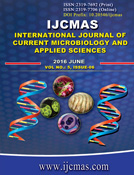


 National Academy of Agricultural Sciences (NAAS)
National Academy of Agricultural Sciences (NAAS)

|
PRINT ISSN : 2319-7692
Online ISSN : 2319-7706 Issues : 12 per year Publisher : Excellent Publishers Email : editorijcmas@gmail.com / submit@ijcmas.com Editor-in-chief: Dr.M.Prakash Index Copernicus ICV 2018: 95.39 NAAS RATING 2020: 5.38 |
SLE is a chronic autoimmune disorder in which multiple systems of the body are affected. Infections are one of the leading causes of morbidity and mortality in SLE patients and the percentage of patients who develop infections range from 33% to 50%. Hence the present study was conducted to isolate and identify the various bacterial and fungal pathogens associated with infections in patients with SLE. 110 SLE patients with clinically suspected infections were included in this study. Appropriate samples were collected and processed to isolate bacterial and fungal pathogens. The pathogens were identified using standard methods and their antimicrobial susceptibility patterns studied using CLSI guidelines. Infectious episodes occurred in 60 (54.55%) patients. Urinary tract was the most common site of infection followed by respiratory tract. Bacterial infections were common accounting for 93.24% of infections. E.coli was the most common bacteria and Candida was the common fungus isolated. The most common sites of infection and isolated pathogens were similar to those in the general population. Since infections are a major cause of morbidity and mortality in SLE patients, all fevers should be evaluated to rule out infections.
 |
 |
 |
 |
 |